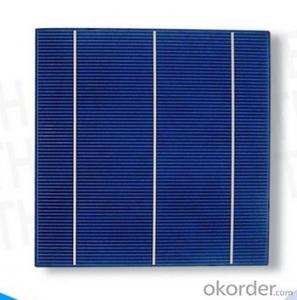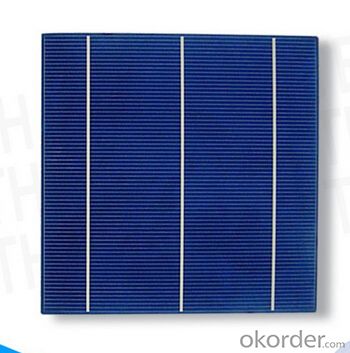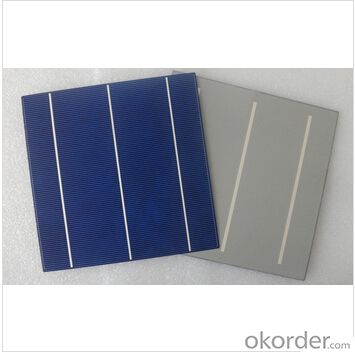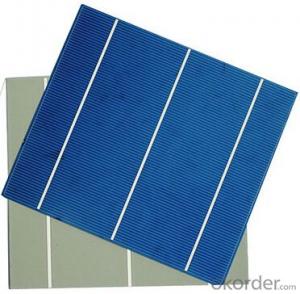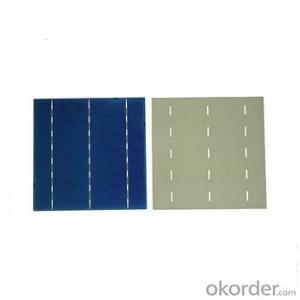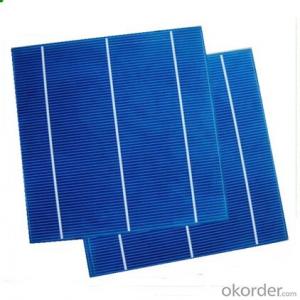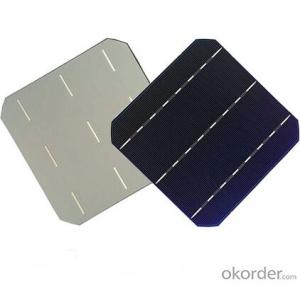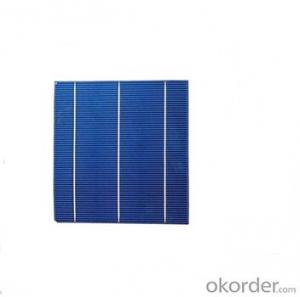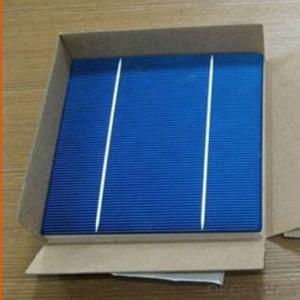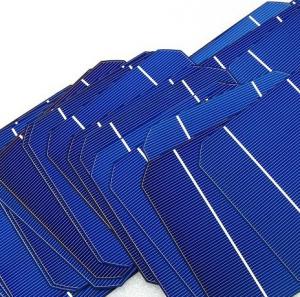High Quality Floating Polycrystalline Solar Cells 17.00-17.19effy
- Loading Port:
- Shanghai
- Payment Terms:
- TT or LC
- Min Order Qty:
- 1000 pc
- Supply Capability:
- 1000000 pc/month
OKorder Service Pledge
OKorder Financial Service
You Might Also Like
Solar Cells:
solar cells, when struck by photons of light from the sun, generates an electrical current which can then be used to power DC or AC electrical loads.
A solar cell is made of silicon. Computer chips are made of this same material. Basically, when light strikes the surface of a solar cell some of it is absorbed into the silicon. This light energy bumps the electrons loose and causes energy to flow
Solar cells is made by solar wafer, it has three categories of solar cell right now, monocrystalline polycrystalline and thin film,These cells are entirely based around the concept of PN junction, which is the critical part of solar module, it is the part that can convert the light energy into electricity, the thickness is from 180um to 200um, with even busbars to conduct electricity, textured cell can decrease diffuse reflection; they are often electrically connected and encapsulated as a module. Photovoltaic modules often have a sheet of glass on the front (sun up) side, allowing light to pass while protecting semiconductor wafers from abrasion and impact due to wind-driven debris, rain, hail, etc. Solar cells are also usually connected in series in modules, creating an additive voltage. Connecting cells in parallel will yield a higher current;With high quality and stable quality. Our Cells can greatly improve the performance of Solar Modules.
Specifications
Efficiency Code | 170 | 168 | 166 | 164 | 162 | 160 | 158 | 156 |
Efficiency Eff(%) | 17.00-17.19 | 16.80-16.99 | 16.60-16.79 | 16.40-16.39 | 16.20-16.39 | 16.00-16.19 | 15.80-15.99 | 15.60-15.79 |
Power Ppm(w) | 4.14-4.19 | 4.09-4.14 | 4.04-4.09 | 3.99-4.04 | 3.94-3.99 | 3.89-3.94 | 3.85-3.89 | 3.80-3.85 |
Max.Power current Ipm(A) | 7.97 | 7.91 | 7.82 | 7.77 | 7.72 | 7.67 | 7.62 | 7.56 |
Min.Power Current Ipm(A) | 7.73 | 7.68 | 7.58 | 7.54 | 7.49 | 7.44 | 7.39 | 7.34 |
Short Circuit Current Isc(A) | 8.45 | 8.40 | 8.34 | 8.30 | 8.25 | 8.21 | 8.15 | 8.10 |
Max Power Voltage Vpm(V) | 0.522 | 0.520 | 0.519 | 0.516 | 0.513 | 0.511 | 0.508 | 0.505 |
Open Circuit Voltage Voc(V) | 0.624 | 0.622 | 0.620 | 0.618 | 0.616 | 0.614 | 0.612 | 0.609 |
Solar Cells Advantage:
• High efficiency and stable performance in photovoltaic conversion.
• Advanced diffusion technique ensuring the homogeneity of energy conversion efficiency of the cell.
• Advanced PECVD film forming, providing a dark blue silicon nitride anti-reflection film of homogenous color and attractive appearance.
• High quality metal paste for back surface and electrode, ensuring good conductivity, high pulling strength and ease of soldering.
• High precision patterning using screen printing, ensuring accurate busbar location for ease with automatic soldering a laser cutting.
Features:
High efficiencies up to 16.4%
Proven long term mechanical stability of silicone
Make of highly purified poly silicone
Three bus bars for reduced series resistance and improved module and cell efficiency
Blue anti-reflecting coating ensures improved light absorption and increased efficiency
Acid texturization offers a uniform appearance and virtually invisible crystal structure
Excellent low light behavior for improved energy yield
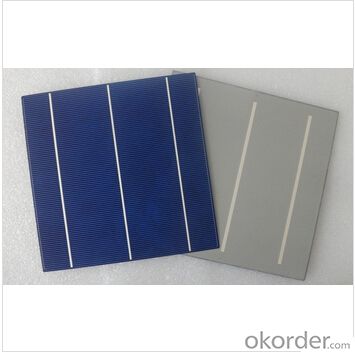
FAQ
We have organized several common questions for our clients,may help you sincerely:
①What price for each watt?
It depends on the efficiency of the solar cell, quantity, delivery date and payment terms.
②How long can we receive the product after purchase?
In the purchase of product within three working days, We will arrange the factory delivery as soon as possible. The pecific time of receiving is related to the state and position of customers.Commonly 7 to 10 working days can be served.
③Can you provide the peripheral products of the solar panels, such as the battery, controller, and inverter? If so, can you tell me how do they match each other?
Yes, we can, we have two companies for solar region, one is CNBM International, the other is CNBM engineering Co.
We can provide you not only the solar module but also the off grid solar system, we can also provide you service with on grid plant.
④What is your warranty of solar cell?
Our product can promise lower than 0.3% open box crack, we support claim after opening the box if it has crackm color difference or sth, the buyer should give pictures immediately, we can not accept the claim after the solar cell has assembled to solar panel.
• Timeliness of delivery
• ⑤How do you pack your products?
We have rich experience on how to pack the solar cell to make sure the safety on shipment, we could use wooden box or pallet as buyer's preference.
How Monocrystalline Cells Are Made
As the name implies this type of solar panel are unique in their use of a single, very pure crystal of silicon. Using a process, similar to making semi-conductors, the silicon dioxide of either quartzite gravel or crushed quartz is placed into an electric arc furnace. Heat is then applied and the result is carbon dioxide and molten silicon. This simple process yields silicon with one percent impurity, useful in many industries but not the solar cell industry, which requires a much higher purity level.
This is accomplished by passing a rod of impure silicon through a heated zone several times in the same direction. This procedure "drags" the impurities toward one end with each pass. At a specific point, the silicon is deemed pure, and the impure end is removed.
Next, a silicon seed crystal is put into a Czochralski growth apparatus, where it is dipped into melted polycrystalline silicon. The traditional way of adding boron, is to introduce a small amount of boron during the Czochralski process. The seed crystal rotates as it is withdrawn, forming a cylindrical ingot of very pure silicon.
Wafers are then sliced out of the ingot, then sealed back to back and placed in a furnace to be heated to slightly below the melting point of silicon (1,410 degrees Celsius) in the presence of phosphorous gas. The phosphorous atoms "burrow" into the silicon, which is more porous because it is close to becoming a liquid. The temperature and time given to the process is carefully controlled to ensure a uniform junction of proper depth.
- Q: Can solar cells be used to power wireless communication networks?
- Yes, solar cells can be used to power wireless communication networks. Solar cells are capable of converting sunlight into electricity, which can be stored in batteries or directly used to power various devices, including wireless communication equipment. This renewable energy source offers a sustainable and environmentally friendly solution for powering wireless networks in remote or off-grid locations. Additionally, advancements in solar cell technology have made them more efficient and cost-effective, making them a viable option for powering these networks.
- Q: Can solar cells be used for powering telecommunications towers?
- Yes, solar cells can be used to power telecommunications towers. In fact, solar power is increasingly being used as a reliable and sustainable source of energy for powering remote or off-grid telecommunication infrastructure. Solar panels can be installed on the rooftops or adjacent to the towers to generate electricity from sunlight, providing an eco-friendly and cost-effective solution for powering these towers.
- Q: Can solar cells be used for powering space missions?
- Yes, solar cells can be used to power space missions. Solar cells, also known as photovoltaic cells, convert sunlight directly into electricity. They have been widely deployed in space missions to provide power for satellites, space probes, and even space stations like the International Space Station (ISS). Solar cells are a reliable and efficient source of renewable energy in space, as they can generate electricity even in the absence of an atmosphere.
- Q: Can solar cells be used for powering remote weather monitoring stations?
- Yes, solar cells can be used for powering remote weather monitoring stations. Solar cells, also known as photovoltaic cells, convert sunlight into electricity, which can be used to power various devices and systems. Remote weather monitoring stations often require a consistent and reliable source of power, especially in locations where access to the electrical grid is limited or non-existent. Solar cells provide a sustainable and environmentally-friendly solution for these stations by harnessing sunlight to generate electricity, ensuring continuous operation of the monitoring equipment.
- Q: Do you believe you can make a solar cell by using kitchenware?
- Really? Can you show me how?
- Q: Can solar cells be used for powering sports stadiums?
- Yes, solar cells can be used for powering sports stadiums. They have the ability to generate electricity from sunlight and can be installed on the roof or surrounding areas of the stadium. This renewable energy source can help reduce the carbon footprint of the stadium and contribute to a more sustainable and environmentally friendly power supply.
- Q: Can solar cells be used in data centers?
- Yes, solar cells can be used in data centers. They can be installed on the roofs or surrounding areas of data centers to generate clean and renewable energy. This helps reduce the reliance on grid power and lowers the carbon footprint of the data center operations. However, the feasibility and effectiveness of using solar cells in a data center would depend on factors such as the available space, climate conditions, and energy requirements of the facility.
- Q: The working principle of solar cells includes the three processes
- In the solar cell pn junction on both sides of the lead-out electrode, and connected to the load, then in the external circuit that is generated by the photogenerated current to obtain power output, so that solar cells put solar (or other light) directly into electrical energy
- Q: Can solar cells be used in electric vehicle charging stations?
- Yes, solar cells can be used in electric vehicle charging stations. Solar panels can capture sunlight and convert it into electricity, which can then be used to charge electric vehicles. This approach is known as solar-powered charging stations and is an environmentally friendly alternative to traditional grid-powered stations.
- Q: What is the role of surge protectors in solar cell systems?
- The role of surge protectors in solar cell systems is to safeguard the system and its components from voltage spikes and power surges. They act as a protective barrier, absorbing excess voltage and diverting it away from sensitive equipment, such as solar panels, inverters, and battery systems. By preventing damage caused by electrical surges, surge protectors help to ensure the longevity and efficiency of solar cell systems.
Send your message to us
High Quality Floating Polycrystalline Solar Cells 17.00-17.19effy
- Loading Port:
- Shanghai
- Payment Terms:
- TT or LC
- Min Order Qty:
- 1000 pc
- Supply Capability:
- 1000000 pc/month
OKorder Service Pledge
OKorder Financial Service
Similar products
Hot products
Hot Searches
Related keywords
